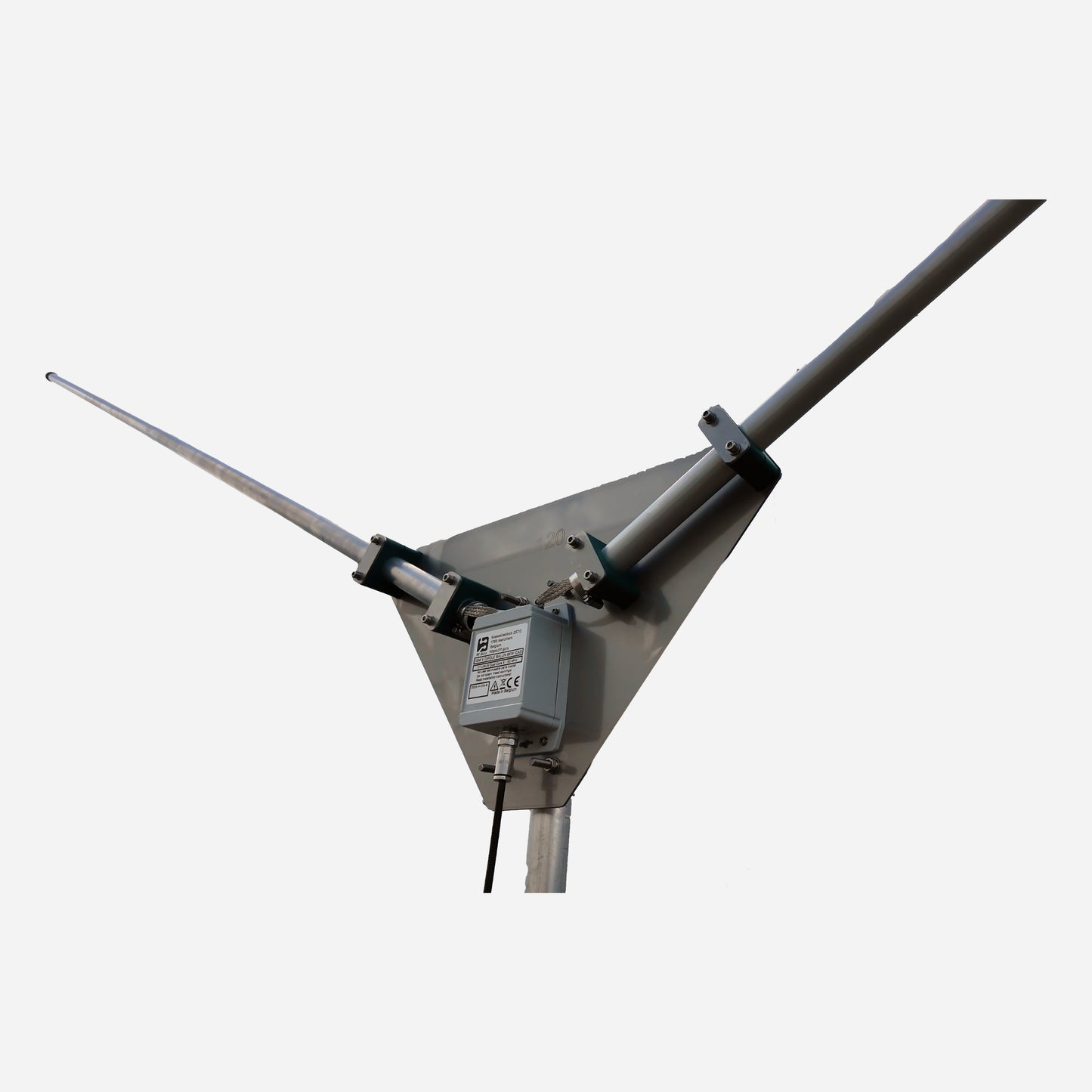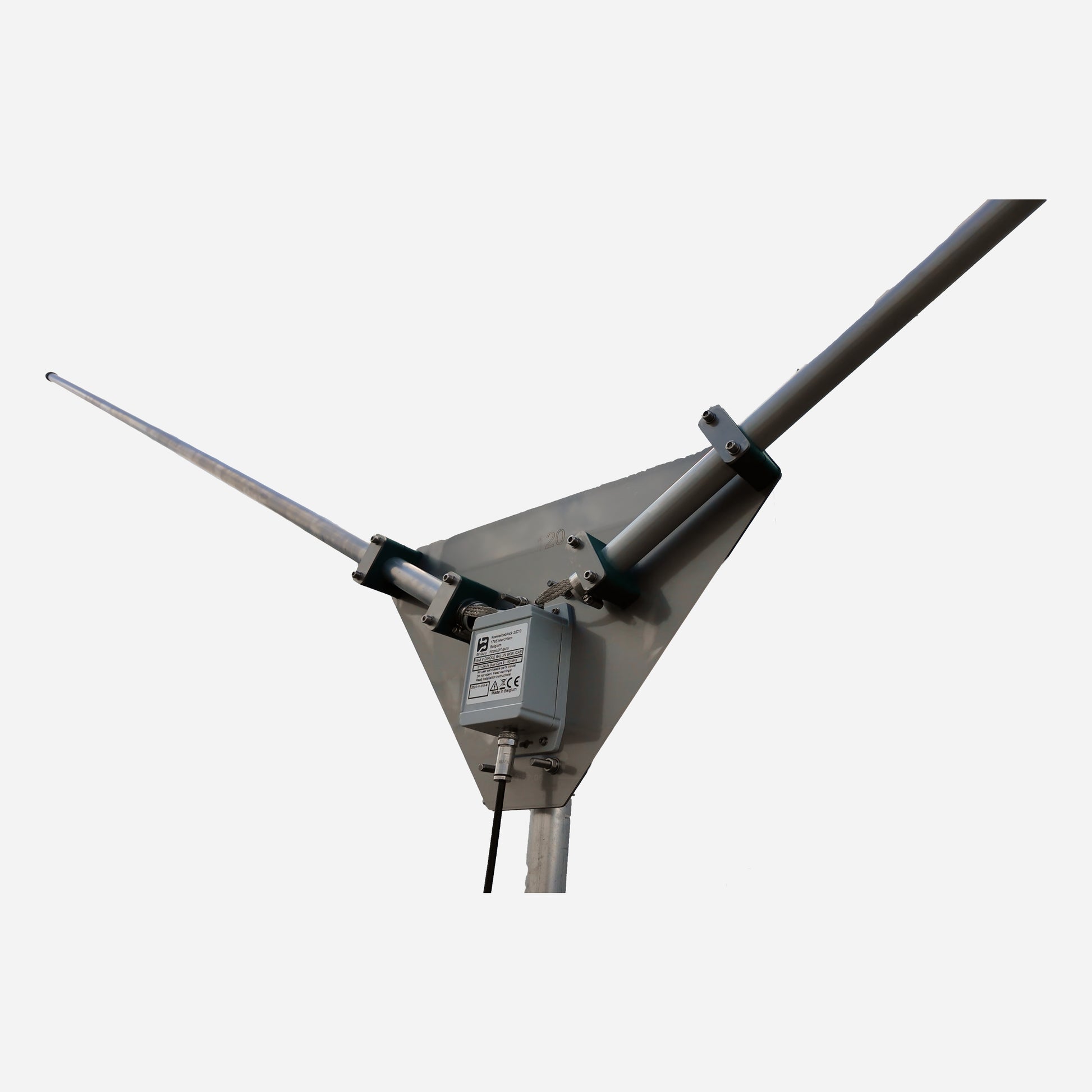RF Guru
1kW XentriX 20M - 6M
1kW XentriX 20M - 6M
Couldn't load pickup availability
The TermiLoop 160–6 m is a broadband terminated end-fed loop engineered as a smarter alternative to classic T2FD/BBTD designs. By folding a 27 m wire with controlled 20 cm spacing and placing a non-inductive termination at a low-current, high-voltage node, it preserves the smooth, stable SWR behavior you want across 160–6 m—with less dissipation loss than legacy terminated antennas.
Specs at a Glance
| Frequency Coverage | 1.8–54 MHz (160–6 m) |
| Power Rating | 100 W FT8/FT4, up to 200 W SSB/CW |
| Feed System | 4:1 UNUN (50 Ω systems), weather-sealed |
| Termination | ~500 Ω non-inductive resistor (100 W class) at HV/low-current node |
| Total Wire Length | 27 m perimeter (typical flattop span < 14 m due to folding) |
| Leg Spacing | 20 cm via weather-resistant spreaders |
| Enclosure Spacing | UNUN and resistor box mounted ~11 cm apart |
| Typical SWR | < 3:1 across HF (installation dependent); internal ATUs match easily |
What’s Included
- 4:1 UNUN (100 W version), weather-sealed
- Resistor enclosure with non-inductive ~500 Ω termination (100 W)
- 27 m antenna wire (XLPE sheathed, flexible)
- Fold spacers (20 cm) and hardware
- Ceramic egg insulator and bulldog grip for the far end
- Cold-leg link wire (~55 cm) between UNUN cold side and resistor box
QRO version will include a high-power termination and is coming later this year.
Physical Layout & Dimensions
- Total wire length: 27 m perimeter. Installed flattop span is typically < 14 m thanks to folding.
- Spacing: Parallel legs kept at 20 cm separation by spreaders.
- Feedpoint: 4:1 UNUN; the cold side links to the resistor box with a ~55 cm insulated wire.
- Enclosures: UNUN and resistor box mounted ~11 cm apart for compactness.
- Termination: ~500 Ω non-inductive resistor placed at the HV/low-current node for lower dissipation across HF.
Why This Geometry Works
- Lower loss vs T2FD/BBTD: Smarter termination placement reduces heat and increases radiated power.
- Traveling-wave behavior: Suppresses strong resonances, keeping the SWR smooth & predictable across 1.8–54 MHz.
- Impedance control: Feedpoint stays ~100–300 Ω; transformed via 4:1 UNUN into ~25–75 Ω—easy for modern tuners.
Measured SWR (6 m Flattop)
With the TermiLoop installed as a 6 m high flattop, measured SWR is < 3:1 across 160–6 m. This ensures straightforward matching with any internal ATU or a compact external tuner.

Fine-tuning via the far-end clamp/connector lets you nudge the window slightly higher or lower, but trimming is optional.
Installation Notes
- Heights: 5–6 m for NVIS; 7–8 m for balanced coverage; 10–12 m to favor DX angles.
- Sloper option: Keep feedpoint lower (5–6 m) and far end higher (10–12 m) to bias higher-band DX while keeping low-band NVIS.
- Choking: Add a ferrite line isolator on the feedline to tamp down common-mode. High-power isolator options are listed below in Optional Accessories.
- Tuning expectation: < 3:1 SWR on all HF bands out of the box; internal tuners handle it easily.
For all bolts, screws, and electrical interfaces, apply AL-1100 aluminum paste during assembly to prevent galvanic corrosion and keep contact resistance low in outdoor exposure.
How often? One thorough application at installation is typically sufficient. In harsh coastal or polluted environments, reapply every 2–3 years during a visual inspection, or sooner if you open/retorque joints.
Optional Accessories
- Mounting on a mast: Requires 2 × RVS INOX 316 Steel BALUN/UNUN Mounting Kits for secure installation.
- Ferrite core (complementary): A Type 31 split core (ID 25 mm, OD 56 mm, length 43 mm) is recommended. This is sufficient for 100 W max power only.
- For higher power (QRO): Use a 9 kW Wide Band HF High Power +30 dB CMR Line Isolator (1.5–30 MHz) to ensure safe operation at kilowatt levels.
- No mast available? Our Heavy-Duty Ballast Frame for 60 × 40 cm tiles with a Ø60.3 mm pole (4–6 m) is ideal to get the TermiLoop clear of obstacles. With the 6 m pole, you achieve proper clearance; the far end can be guyed with our Mastrant Guying Set (30 m rope) to any nearby support structure.
Operating Characteristics by Band
- 160–80 m: Strong NVIS at modest heights; impressively effective for a compact footprint.
- 60–40 m: Mixed NVIS/low-angle behavior—regional plus DX.
- 30–10 m: Forward bias develops along the hot-leg direction; sloper setups enhance this.
On 40–160 m the TermiLoop delivers stronger NVIS signals than traditional T2FD/BBTD-style antennas of the same size. The reason isn’t “more perimeter radiation” — it’s smarter geometry. By placing the ~500 Ω load at a low-current, high-voltage point, far less RF is wasted as heat compared to classic designs. That means more of your power actually goes into the wire and launches upward for reliable NVIS coverage, while the loop form keeps the impedance smooth and tuner-friendly across all HF bands.
Key Advantages
- Compact install: < 14 m span fits small gardens.
- Broadband stability: Smooth impedance and SWR from 1.8–54 MHz.
- Lower loss than T2FD/BBTD: Smarter termination placement.
- Predictable tuning: Consistent behavior across height and weather changes.
- Quiet on RX: Loop geometry and damping reduce noise ingress.
Notes on SWR & Real-World Installs
Tests are performed in open conditions at ~6 m AGL flattop. Results vary with height, surroundings, soil, and feedline. Always measure and trim on site if desired.
Mini-FAQ
- Do I need a tuner? — Yes. SWR is < 3:1 across HF, so most internal ATUs will match it easily.
- Can I run high power? — Today’s model is 100 W FT8/FT4 and 200 W SSB/CW. A 1 kW QRO version is coming later this year.
- Is it good for RX? — Yes. Loop geometry and damping make it very quiet for SDR/skimmer use.
- Small garden friendly? — Yes. Folded span is typically under 14 m.
- Better as flattop or sloper? — Both work. Sloper can add forward bias on higher bands.
- Why not put the resistor after ~14 m? — The TermiLoop places the ~500 Ω load at a low-current, high-voltage node. That cuts resistive heating and increases radiated power versus putting the load where current is still high.
- Why is it a loop, not a straight wire? — The folded loop creates a traveling-wave path that smooths impedance and tames strong resonances, keeping SWR stable and tuner-friendly across 160–6 m while reducing common-mode pickup.
- Why parallel wires with 20 cm spacing? — The controlled spacing preserves the folded-loop effect for predictable current distribution (nice flat SWR) and keeps the geometry mechanically stable so performance doesn’t drift.
- Why is it more efficient for NVIS on 40–160 m? — Because less RF is wasted in the resistor. By loading at the low-current point, more power is launched upward for reliable NVIS coverage, compared to T2FD/BBTD designs.
Share

